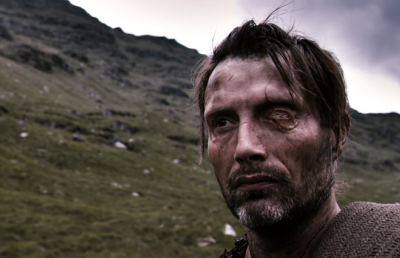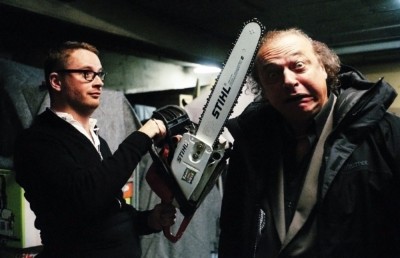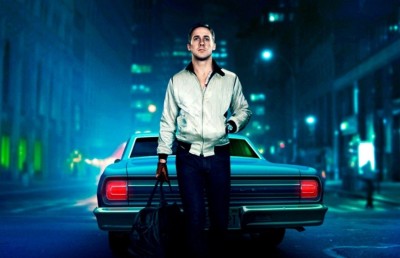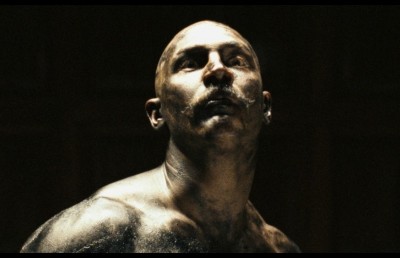Fear X: An Obsessive Inquiry into Knowledge, Art and Uncertainty
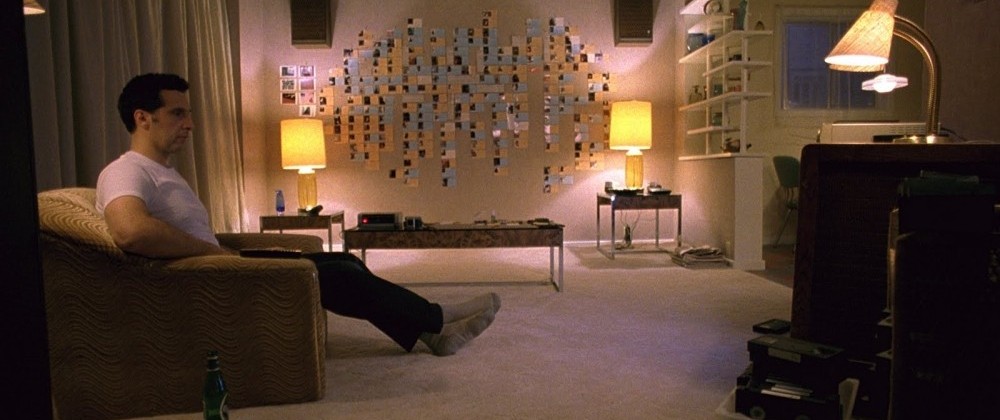
Nicolas Winding Refn’s early (3rd) feature Fear X (2003) marked his first film largely (some studio interiors were shot in Denmark) filmed outside his native Denmark (Hollywood in name only, since it was filmed in Winnipeg, Canada, and is a co-production with Canada). It is also the first of his films marked by his by now known propensity of marring a popular genre with art house sensibilities. Fear X is a mystery-thriller which borrows far more from the world of art house, experimental and modernist auteurism than popular Hollywood. Yes it stars John Torturro as a man in search for the meaning to his wife’s violent death, to a mystery which has stripped him of the will to live a normal life, but Refn’s natural inclination is to paint the film in dark velvet and employ colors from the palette of directors such as Welles, Bergman, Antonioni, Lynch, Coppola, Tarkovsky, and perhaps even Brakhage. Not exactly a roll call of popular genre masters.
The mode (if not genre) that Refn seems to have found, or backed into, that best accounts for his penchant to mix popular genre with art house is what is sometimes referred to as ‘mind fuck’ films; or what film critic Michael Barrett has christened (thankfully!) with a much more sophisticated and nuanced moniker, the “millennial unreality”. In the tenth anniversary issue of the journal you are presently reading, Offscreen, my own response to one of the survey questions about the period in question, 1997-2007 – “What have been some of the more important developments and trends in cinema (in terms of technology, subject matter, genre, or cultural impact”– was to invoke this (since christened by Barrett as ‘millennial unreality’) trend: “In terms of narrative feature film trends, one of the most fascinating (and with endlessly rewarding returns) is certainly the truckload of recent films which place viewers in the challenging position of having to think along with a main character who is slowly losing touch with their reality and descending into a pure subjective hell. These films start off as seemingly straight forward, linear narratives, but then ‘snap’ and leave viewers in an ontological lurch, forcing us to wonder: What happened? What is real and what is imagined? Is the hero/heroine losing his/her mind or are things really conspiring around them? A sampling of ‘mind fuck’ films include Chasing Sleep (Michael Walker, 2000), The Dark Hours (Paul Fox, 2005) American Psycho (Mary Harron, 2000), The Machinist (Brad Anderson, 2004), Fear X (Nicolas Winding Refn, 2003), Eyes Wide Shut (Stanley Kubrick, 1999), The Fight Club (David Fincher, 1999), S (Guido Hendericks, 1999), Spider (D. Cronenberg, 2003), Paranoia 0/One Point O (Jeff Renfroe, Marteinn Thorsson, 2004), Lost Highway (David Lynch, 1997), Mulholland Dr. (Lynch, 2001), INLAND EMPIRE (Lynch 2006), and Open Your Eyes (Alejandro Amenábar, 1997) [not to mention the science-fiction “is-it-reality-or-virtual-reality” take on the same theme, Cube (Vincenzo Natali, 1997), Matrix (Andy/Larry Wachowski), ExIstenZ (David Cronenberg, 1999), and Dark City (Alex Proyas, 1998)].
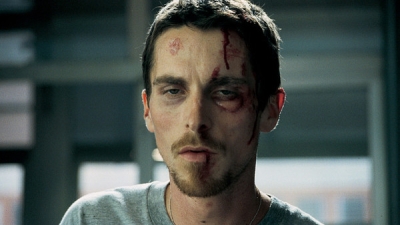
Christian Bale (also in American Psycho) in The Machinist
And for the same 10th anniversary celebration survey, in my own selection of “An overlooked film that you feel is worthy of critical appraisal (or reappraisal)” I cited as one of my choices Fear X, which I described as follows: “John Torturro stars as a security guard obsessed with the minutiae of his wife’s unexplained murder. The deeper he goes into his personal, amateur investigation and the more we fall into an organically induced (set design, sound, point of view, etc.) subjective quagmire. A partial homage to Blow-Up (with shades of classic 1970s giallo), with a definitive Lynchian feel and a wonderful minimalist score by Brian Eno, Fear X, is one of the most experimental narratives of any ‘mainstream’ film I have ever seen. No wonder it tanked at the box-office. Directed by a Dane, shot in Winnipeg, Canada, and with a mixed cast of American and Canadian actors.”
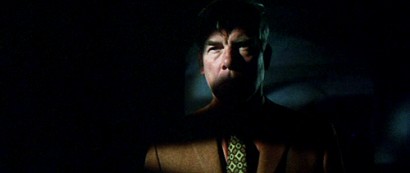
Lee Marvin in Boorman’s fascinating mind trip film Point Blank
In Barrett’s “grand un-unified theory” of the Millennial Unreality film he notes 1999 as the key year, when he saw a large number of films and noticed a trend of films that “…were about the same thing. They were about our lack of faith in reality” (p. 19). Barrett notes the importance of Science-Fiction writer Philip K. Dick, whose works were increasingly adapted in this period; and films that “pertained to subjectivity, not fantasy” (p. 21). Barrett admits there were antecedents, The Cabinet of Dr. Caligari, Vertigo, Last Year at Marienbad, An Occurrence at Owl Creek Bridge, Carnival of Souls, Point Blank, Blow-Up, If, Angel Heart, Siesta, and Jacob’s Ladder. But nothing to suggest the outpouring of these films in the ten year period of 1999-2009 (Barrett identifies a partial listing of over 100 films).
Barrett cites the two key social events that are behind the increase in these films marked by paranoia and a breakdown between real/unreal, subjective/objective is the worldwide apocalyptic angst surrounding the millennial shift from 1999 to 2000 and of course the terrorist attacks of September 9, 2001. Barrett explains, “I felt this was a sign of millennial jitters, like stories of the Y2K bug that was supposed to wipe us out, erase our memories and cause panic in the streets. These movies were channeling the same restless, uneasy vibe….These movies were about uncertainty, about disorientation, about being wrong, and they didn’t resolve their problems neatly, even when it seemed they did. They were movies more full of questions than answers, sometimes told in a narrative style that is itself disorienting, full of dislocations and flashbacks or teases about what we’re really seeing” (p. 19).
This last phrase is a succinct explanation of how the viewer feels watching Refn’s Fear X, a film where one doubts the veracity or source point of pretty much EVERY scene in the film (how much of this is a projection of Harry Cain’s imagination, fears, desires, suppositions, in short, his subjectivity?). In this respect it slightly ill fits my earlier definition (or expands on it) of films that begin linearly or grounded in a sense of reality, and then turn to the realm of ambiguity; the ambiguity is planted in Fear X right from the start. Cain is painted as such an obsessive ‘watcher’ constantly looking for the ‘truth’ to his wife Claire’s death, that his every moment of existence seems to be taken up by this quest for truth; every thought, action, gesture in the film seems to be a by-product of his obsessiveness; and asks the viewer to question what is ‘appearance’ (the material surface presentation of something, which can often be a misrepresentation) and what is ‘reality’ (a more accurate representation of what we think we have seen); or what Bertrand Russell simply put as, “the distinction between….what things seem to be and what they are.”
With this in mind, it is not surprising to suggest (as others already have) that Refn borrows liberally from one of the cinema masterpieces of ‘appearance vs. reality’, Michelangelo Antonioni’s Blow-Up (1969). Along with this classic antecedent to the mind fuck film, Refn borrows from a core group of ‘mind-fuck’ (or mind fuck antecedent) films, as a source point for his visual and aural stylings: Coppola’s The Conversation (1974), Hackman’s paranoid sound man is called Harry Caul, to Refn’s paranoid security guard Harry Cain; Lynch’s Elephant Man and Lost Highway; the Coen brothers’ Barton Fink; Citizen Kane, the character name of Harry Cain may be a reference to the titular character Citizen Kane, another man whose puzzle-like life remains an unsolved mystery.
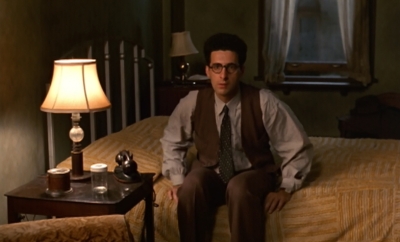
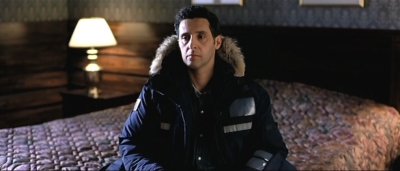
Torturro’s deja vu: Barton Fink & Fear X
Right from the provocative opening shot of the film, a medium shot of a window with its curtains partially opened revealing a house across the street, with a dark silhouetted hand entering the frame to pull open the curtain and reveal a blond-haired woman standing in the snowy setting, we are brought into the world of Harry Cain, and how he sees the world. The woman begins to walk away but turns to look back, returning Cain’s imminent gaze, which we get in the next shot, a slow dolly forward toward his pained face shot through the reflected window.
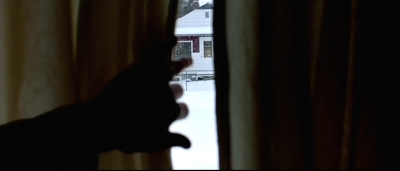
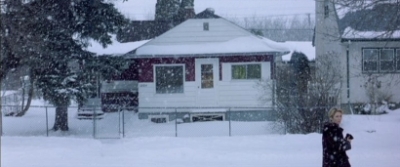
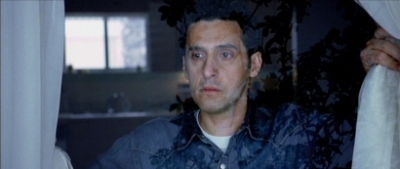
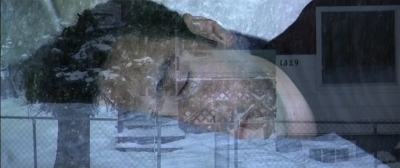
The opening five scenes feature Cain watching intently: first at the noted blonde haired woman, who we soon learn is his dead wife Claire (Jacqueline Ramel), walking toward the house across the street, in slow motion and with snow falling (an image which also suggests the famous snow globe of Citizen Kane); the image is coded retroactively as a dream, as it ends when Cain wakes from sleep. (This opening scene has important ramification for Cain’s actions and I will return to it later.) The camera then ‘looks’ as it pans and tracks to follow Cain walking to the kitchen of his small, simple house, preparing a cup of coffee (the character of Kate will be seen drinking coffee in her kitchen later, in one of the many rhyming moments in the film-see photo below). The camera then dollies back slowly from a center framed newspaper clipping reading “Two Killed In Mall Slaughter” to frame the whole wall filled with annotated pictures of people and various newspaper clippings, a monument to his obsessive quest for the truth. The simple fact which is oddly left dangling most of the film, is that there were two people murdered that day (another clipping reads “Double Murder in Quiet Canwood Plains”), yet there is almost exclusively talk of one death, his wife’s. Who was that second person murdered? Does this relate to the fact that we twice hear Cain tell someone, “I am not a murderer?” The only possible answer comes much later, at the 60 minute mark, in the scene where Lieutenant Peter Northrup (James Remar) has a sitting with his superiors (scene to be discussed later).
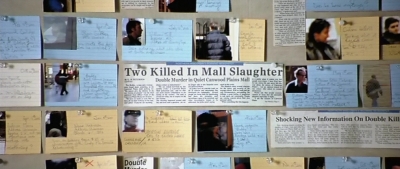
Cain steps out of his house and then we cut to an intriguing shot of the camera ‘looking’ as it pans slowly in a 180 degree arc from Cain’s house to the house across the street at 1329 (the camera, though not subjective, is a reflection of what is on Cain’s mind: the house at 1329).
The next scene (second) cuts to the mall where he works as a security guard, and we watch Cain spying from a top landing at a man about to shoplift. The camera zooms in slowly from his high angled position to the man in the store as he places a dress into his bag and walks out of the store. Cain calls in the crime, then follows the man and arrests him. In the mall lockers Cain receives more illicit video tapes from a co-worker, and then returns home to watch them, forming the third consecutive scene comprised around Cain watching intently. Cain sits watching the tapes in fast motion, looking for any possible clue. The fourth scene takes us back to his mall, where he flips through a stack of polariods before noticing someone looking at him, which in his natural state of paranoia, he reads with suspicion; in turn the man is himself spooked by Cain’s gaze and he walks away. Cain is then called into his superior’s office to be lightly reprimanded for his excessive vigilance toward the mall clients. His boss says, “We’ve had a few incidents lately….We can’t afford having people feeling uncomfortable shopping here,” a comment which suggests that Cain is ‘looking’ too intently at the people in the mall (an indirect accusation of his obsessive voyeurism).
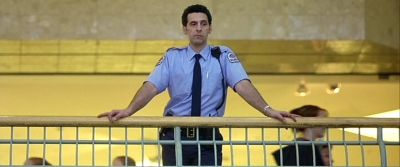
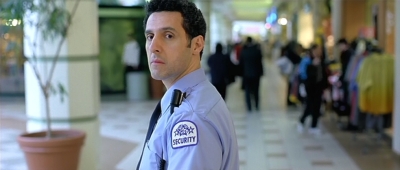
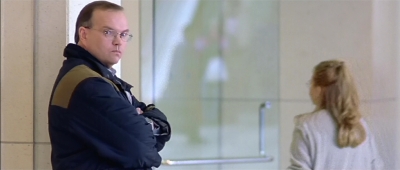
Cain’s obsessive gaze continues
Scene five returns to his house, with Brian Eno’s magnificent ambient drones increased to add a sense of menace as Cain views more video tapes. Cain freeze frames the surveillance video footage, and begins taking polaroids of the stilled images and then sticking them on the living room wall, in an attempt to make some narrative sense of his mystery; this scene strongly invokes the same obsessive spirit shown by the photographer in Blow-Up, who takes frame enlargements of a section of the photo he took at a park that may or may not reveal the corpse of a man who may or may not have been killed.
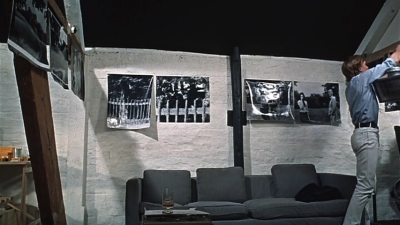
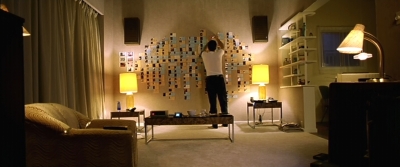
Blow-Up Homage
From a cinephilic/reflexive reading, this wall of small annotated photos looks like the kind of set-up we would see in the office of a first assistant director on a film shoot, with the film’s shooting schedule, or a screenwriter’s character/narrative script arc, or even a director’s storyboard. Indeed, Cain’s manner of watching television, remote control in hand, pausing, fast forwarding, pausing, taking closer extracts to analyze, is synonymous with the type of close formal analysis performed in film studies!
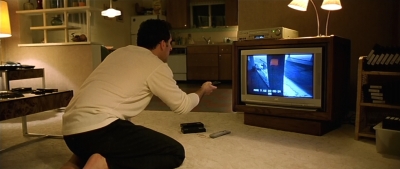
Cain the Film Studies Analyst?
At one point the video image breaks into pure static –a code for moving deeper into Cain’s subjectivity– and then to Cain’s point of view of his wife standing in the kitchen. He gets up from his sofa chair and now sees his dead wife Claire in the bathroom (somehow she moved rooms without our seeing).
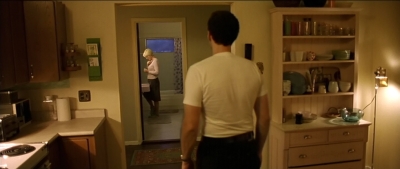
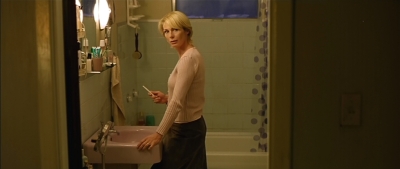
As she did outside in the opening scene, Claire returns Cain’s gaze, looking past the camera eye (so not at to look at us, keeping it Cain’s fantasy). The fantasy seems to end with a simple cut back to a close-up of Cain seated where he was earlier, staring downward, with no announced noticeable change in visual style or mood from one state of reality to another. But then it cuts back to a close-up of Claire in the bathroom, then to Cain standing in front of her, blurring forever the line between real/imagined. The scene continues with a shot behind Cain’s head, with the camera dollying toward and seemingly into the back of his head, before fading to black (this move into a black space, a void, along with the ambient drone sound design, is one of several Lynchian tropes Refn borrows). This is then followed by the first of five abstract ‘red visions’ (at 13’20,” 34”, 69’30”, 71’50”, & 72’50”), the first three preceded by a similar dolly in to the back of Cain’s head) of a silhouetted male figure trying to push through a red tissue like membrane. In this case it is just a hand that is up against the surface, and Refn establishes the first of many graphic match edits when he cuts back to Cain with his hand positioned similarly against a wall, as he turns to look suspiciously around his kitchen as if someone is there looking at him. The scene ends with Cain listening to a phone message left by the local police authorities, informing him of new evidence. This ends the streak of five straight scenes structured around Cain’s intensified gaze.
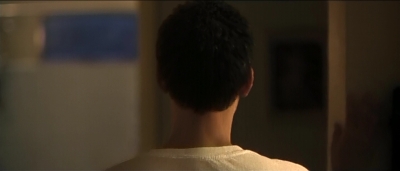
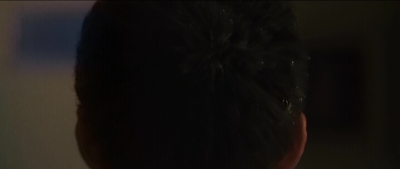
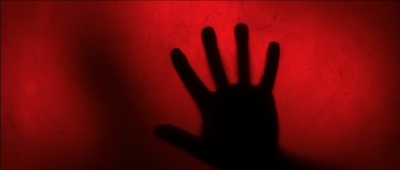
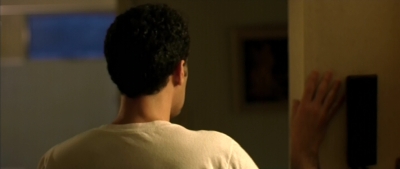
Note position of Cain’s hand
In the next scene, at the police station, the tables turn as the police questioning (and Cain’s behaviour) place Cain on the defensive, the one who is now being ‘looked at.’ Perhaps Cain feels vulnerable because in this scene his penetrative gaze is returned not by a fantasized character, his wife, but a real character, a police detective (unless, of course, you believe this too is part of his imagining).
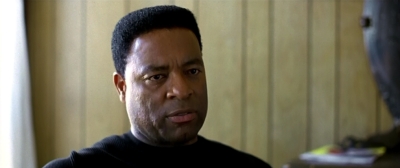
The round of questioning, while somewhat vague and indirect, suggest the possibility that Cain did not really know his wife, or that his wife was not the innocent person he imagined. The police show Cain a picture and tell him, “That man killed your wife,” only the picture is a blur with no distinguishable features, making it a non-clue. [1] Cain asks, “Why did he kill her?” The police replies, “Did you two get along, you and your wife?”
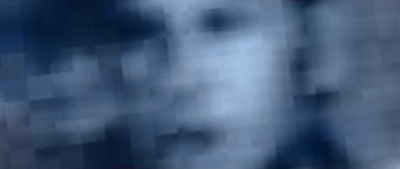
The man who killed Cain’s wife
A subsequent video tape from his friend contains footage of the actual shooting, where a person is seen aiming a gun and firing at a second person, who falls to the ground. The incident is taken from at least five different camera angles, and while it is possible that there were multiple hidden cameras in the car park, it is highly improbable that his friend would have edited them together in such a professional manner! The editing, poor image quality, constant change in angle, combined with Cain’s interjections, makes it hard to be certain what we are seeing, but it appears that the killer shoots twice, the first time at someone we see being shot and falling to the ground and the second time at someone off-screen. This would align with the newspaper clippings stating two murders. The grainy quality of the footage renders a true snuff film feel that gives it a particularly haunting resonance.
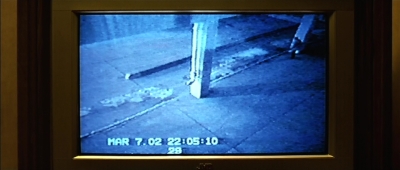
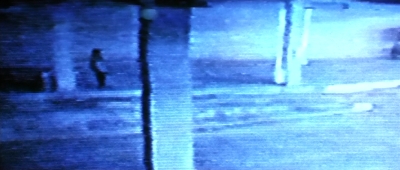
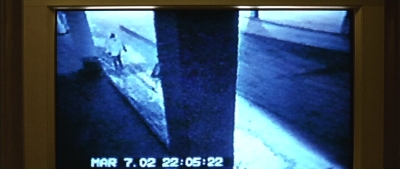
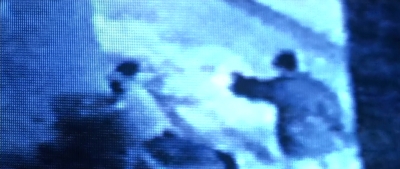
Snuff-like feel
Once Cain has digested this new video footage which seems to depict the shooting of his wife, Cain returns to the key image, the one that is embedded with Cain’s sense of loss, from the film’s opening scene, a slow motion shot of his murdered wife Claire, walking through the snow filled space to the house across the street. The same window space returns, only now it is dark, and Cain’s image looking out is silhouetted. If it is his wife, why does he imagine her walking to this other house? Did he suspect her of infidelity (as perhaps implied by the police questioning)? Or does this house reflect the idyllic life he could have had? He later sees a light turned on, which leads him to call the local real estate agent and discover that the house is rented to a corporate entity. Based on these two facts, one a dream image, he breaks into the house looking for some clue to his mystery. At one point we have an eerie moment where he is crouched inside while another man seen vaguely through a window calls at the front door. Is this Cain’s guilt projecting himself outside the house, the intruder within and without?
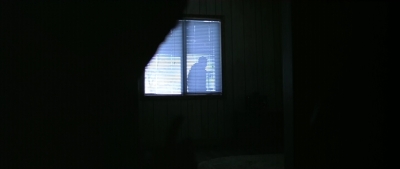
Cain ‘imagines’ himself?
My first thought was the moment where Fred Madison occupies two places at the same time, being both inside and outside the house, in Lost Highway. Cain finds undeveloped photographic negatives in the house, which he gets developed, and reveals a family photograph of a young blond-haired women posing with her young son. By analyzing and enlarging details of the photo he spots the man who took the photo (in a reflection), a diner named ‘Steve & Niki’s’ and a road sign for Montana. He tracks down the location of the diner and heads off to find the woman in the photo. But why? There doesn’t really seem to be any link between this photograph and the murder of his wife.
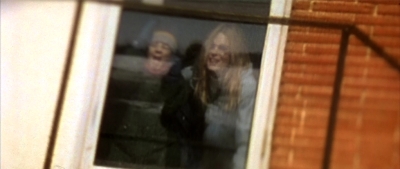
After Cain follows up on his lead to a diner in Montana the film shifts further into David Lynch and Barton Fink territory (most notably by the depiction of the hotel). In the apparent first scene at the Montana hotel, Cain exits room 305, walks down the red velvet colored corridors and then sees his smiling wife in the elevator. He enters to join her and the door shuts; the elevator begins to ascend, stops, and Cain looks as Claire exits and disappears into a black hole of darkness (as he will do near the end).
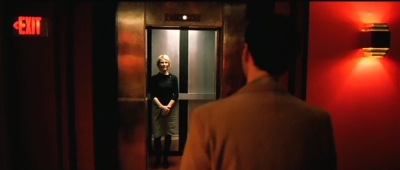
Perhaps a flashback?
However, in the very next scene the arrival at the hotel occurs again: he arrives at a hotel, suitcase in hand, and asks the clerk for room “305.” He walks along the same corridors and enters the same elevator as in the previous scene which, in hindsight, was some sort of a Refnian flashback. In any case, with its womb-like corridors, swathes of darkness, blood red lights, the hotel is a metaphor for Cain’s subconscious.
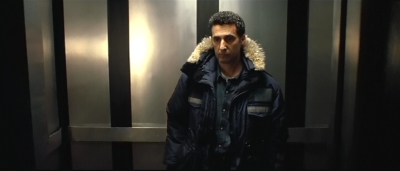
Cain enters his room and soon sits on the edge of the bed, the camera framing him frontally. The next sequence of shots alternates between him alone in his room and then with his wife, caressing and kissing him. The shots of him with his wife can be read as flashbacks, only he is wearing the same winter parka in both sets of shots, making them fantasies instead. Once again, as in the scene at his home described earlier, Refn’s editing erases any distinctions between what is real and imagined, present tense or memory image. As an aside, an interesting essay could be written about the relationship between characters seated or lying on a bed and the descent into subjectivity, usually at either the beginning or end of a film. Think Barton Fink, Fear X (Torturro must have had a strong sense of déjà vu when he sat on the bed to be filmed for the scenes in Fear X!), Eraserhead, Last Year at Marienbad, Cries and Whispers, The Limey, Solaris, Haute tension, Carrie, Friday the 13th, and so on.
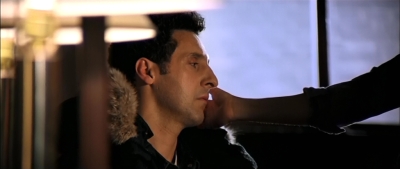
When Cain visits the diner and begins asking questions about the woman in the photo, a sheriff overhears and begins to interrogate him about his motives, much like the police scene in Wisconsin. The sheriff immediately relays the information to a second officer, a decorated lieutenant Peter Northrup (James Remar). Once Northrup learns that there is a man in town asking questions about him and showing around a photograph of his wife and child, he begins to feel as paranoid as Cain. His change in character is noted by his wife Kate, played by Deborah Kara Unger.
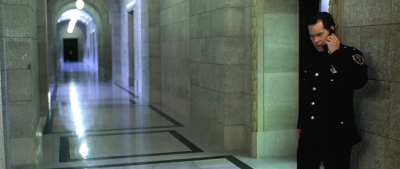
A worried Peter Northrup
In an interesting possible mirroring of Cain’s relationship with his wife, Kate quizzes her husband Peter about why Cain is looking for her, asking what he did on his ‘last trip’ and whether he knew Cain’s wife. With tears in her eyes, she says, “Ever since you got back….something is going on….I’m not afraid of the truth.” The worried look on Peter’s face hints at infidelity. The exchange could very well be one that Cain and Claire had, or one that Cain imagines having with her. This subtextual inference to infidelity may actually be an indirect explanation for the otherwise nonsensical and bizarrely out of place next scene, where a sultry, red dressed woman with a French accent appears out of the blue at Cain’s hotel room door and none too subtly offers herself sexually to Cain. A fidgety Cain seems to resist, telling her, “I’m married,” shutting his eyes to her closely poised body, until she slips out of his still open door. Can this perhaps be an event from his past, ‘corrected’ in his mind’s eye by his guilty conscience to end differently? Perhaps tellingly the scene is followed by a cut to a stark close-up of Peter Northrup. Even the police officers he meets can be seen as doubles (a la Lynch’s Lost Highway) of the police men he speaks with in Wisconsin.
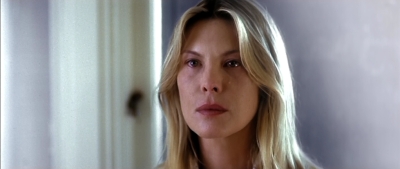
Worried wife Kate, and Mystery Seductress (below)
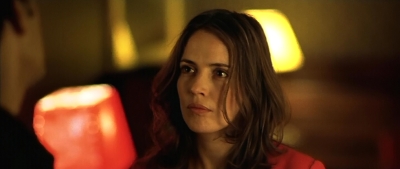
We can only guess that this whole scenario is a projection of Cain’s guilty (but what of?) and paranoid state of mind, and to take this to the next level, suggests that all the events and characters he meets in Montana are subjective projections: the lieutenant named Peter Northrup (James Remar) is the alter ego of himself (the two actors are of a similar build and age, dark-haired, both work on the side of law, have blond-haired wives, act in a paranoid manner, are linked in physical space through several graphic match cuts or rhyming sets, meet with their ‘superiors’, have recently taken ‘trips’, etc.). The blond-haired woman Kate is the projection of his blond-haired wife Claire and the young boy Quinn the projection of his unborn son (Claire was pregnant when she was murdered).
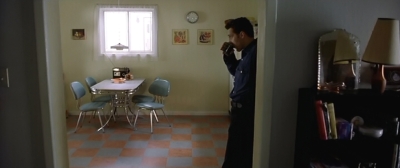
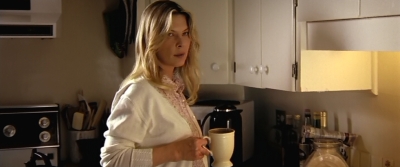
Rhyming shots
The two characters Cain and Northrup, also seem to bleed into each other in odd ways. For example, in the scene where Peter visits his superiors to tell them about the situation with Cain, the two superiors ask, “Do you think he is looking for you… Or is he looking for us?” implicating a larger conspiracy of corruption at play. Cain keeps the matter close to his heart, refuting the suggestion that Cain is looking wider, and he begins to express his guilt over the implied shooting of an innocent, as he tells the older superior, “It was the woman. Her name was Cain….Why did she have to be there right at that time?” Later he concludes, “I killed an innocent woman,” but why does he refer to the wife, the victim of the shooting, with the husband’s name, Cain? The Captain tries to reassure Peter that he was not at fault, but makes no notice of his gender slip. In fact, the ‘cop’ talk is so purposely cliché that we barely notice when a subversive phrase is interjected; like when the Captain tells Northrup, “Corrupt law enforcement is a cancer. It eats at the heart and moral fabric of society. Without law there is no order. What you did was right Peter. He was a corrupt cop. He’s gone.” This is the first instance of an explanation as to who the second murder victim alluded to in the surveillance video might have been. Through their talk it is quickly established that the “innocent woman” that died that night must be Claire, but now the picture of that night that emerges is that Northrup was instructed to eliminate a corrupt cop (or was he an honest one?) and Claire got caught in the cross-fire; although a second victim is not actually seen being shot in the ‘snuff’ surveillance video footage, the one we do see being shot seems male, though we can not be certain, which would make the second off-screen victim Claire. So at first the subtext about the ‘necessary evil’ line seems as if it is referring to the cop that Peter killed, but by the end of their talk, it may be in reference to themselves, and the ‘necessary evil’ is the killing of Cain. The talk continues:
Captain: He may be alone, there may be others, but I know what he knows. Peter I know how difficult this is for you but we have no choice.
Peter: I know. I’ll do whatever is necessary.
Second officer: Would you prefer one of us handle this matter?
Peter: No. Thank you…but I created this situation.
As a direct response to this, the scene cuts to Cain seated at the hotel bar, but framed in the same center space of the frame as Peter was in the shot before.
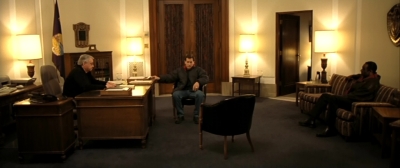
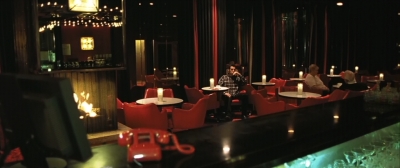
The phone rings, and it is Northrup calling to speak to Cain to set up a meeting, under the pretense that he knows the lady he wants to meet and can lead him to her. He arranges to meet Cain at the hotel, and even tells Cain that he is “in room 503,” which is the reverse of Cain’s room number, 305, echoing all the rhyming and mirroring going on in the film. The dialogue exchange between the two men seated opposite each other in the darkly lit room is both oblique and strangely existential.
Cain: Where’s your friend?
Northrup: Why are you so anxious to see her?
Cain: I need to talk with her.
Northrup: Why?
Cain: I believe she can help me find someone I’m looking for.
Northrup: Who is that?
Cain: Someone who can explain why my wife was murdered….I need to know why my wife was killed.
Northrup: Is that all you need? Then you really don’t want to kill this man?
Cain (for the second time in the film): I’m not a murderer.
(The repetition casts a doubt on its claim, echoed by Northrup’s own retort)
Northrup: And how do you know? Is it worth your life?
Cain: I’m not living anyway.
Northrup: Then let’s go see my friend.
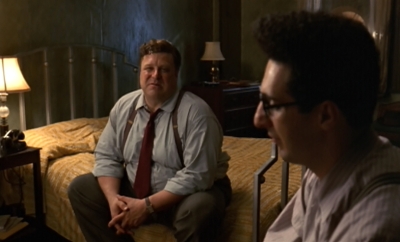
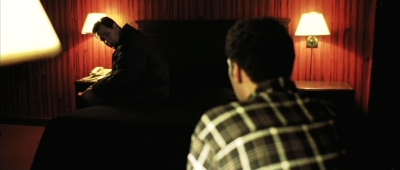
Torturro with two ‘imaginary friends, in Barton Fink & Fear X
As an aside, this dialogue exchange both in its narrative placement near the end and in its underlying content –two men who seem to know death is imminent, yet talk around it– foreshadows in an odd way, the dialogue exchange between the Ryan Gosling character and the Albert Brooks character in the diner at the end of Drive. Outside the room, in front of the elevator, as the two men stand in line, Northrup behind Cain, we hear repeatedly, a faint feminized hush and the third (68’35”) of the slow track-ins to the back of Cain’s head, where we see the all-red image of a man trying to pierce through a membrane. It cuts back to Cain, who asks Northrup, “Did you know my wife?” Northrup replies with a dishonest (literal) truth, “No.” Northrup’s face belies his response. Cain understands. Utters a single word, “You,” and then moves to face Northrup. “Why?” He grabs hold of Northrup’s face, imploring him to answer. Instead we hear Northrup’s gun go off. He utters “sorry” as he pushes Cain into the open elevator, the door shutting between them. Back inside the elevator Cain is alive, wounded, hands stained in blood, but far from dying (dramatic and violent scenes in elevators will be repeated in Drive). As he clenches his bloodied fist we cut to the fourth (and briefest) seemingly non-diegetic abstract shot of a ball of blood red fire (72”). Cain angrily presses the number 5 floor elevator button to return back up to the fifth floor, only to exit into a void of blackness (echoing Claire’s similar action in the earlier flashback/memory), which gives way to the film’s final disturbing montage of rapidly edited, flicker-like blotches of blood red liquid, oozing drop formations, and horizontal streaks, accompanied by scratch on film sounds. The intense montage, which lasts a little over one minute, gives way to a hauntingly quiet, contemplative, almost Tarkovskian (think the ‘room’ in Stalker), long shot image of the hotel elevator door opening to a room filled with shimmering reddish water (or maybe Refn was thinking of Kubrick’s The Shining). For starters, this is probably the most abstract sequence that I’ve seen in an otherwise mainstream fiction film. However, one can chart an interesting narrative development across these five abstract ‘red visions’.
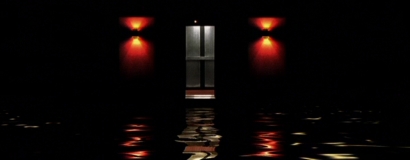
The discursive strategy employed in the first three ‘red vision’ scenes, of a camera dollying in or tracking in to a close-up of a character’s face or back of the head, or elsewhere tracking into a character at a notably slowed down or accelerated pace, are all indicators that suggest immersion into a subjective space, what Bruce Kawin called a ‘dream-screen’. In fact nearly every scene in the film has a discursive strategy which invokes a sense of doubt in the spectator, a doubt of our own faith in the reality of what we are seeing, to quote Barrett, “our lack of faith in reality” –through either a mannered camera movement, the ambient score (by Brian Eno), an acting style which projects a sense of self-persecution or guilt (as in the two police station scenes), editing that makes graphic matches between disparate spaces and character, television static, or the use of dream-like slow motion. The three moments where Refn tracks his camera slowly into the back of Cain’s head/hair can be seen as a formal signifier for ‘getting into his mind’. By calling attention to this discursive strategy Refn invokes other filmic instances of this gesture during similar moments of intense subjectivity: track-in/zooms to the back of a woman’s head/hair in Vertigo, Dellamorte Dellamore, The Piano, to the back of a man’s head in Eraserhead, or indeed to the head of the very same actor Torturro in Barton Fink. Each of these three track-in moments is followed by a (seemingly) non-diegetic all-red insert of what looks like the body or face of an anguished man trying to pierce through a tissue like membrane (A birthing image? A metaphor for Cain’s internal anguish? Or his slow descend into madness?).
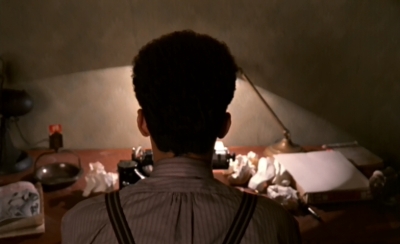
Moving into Barton Fink’s (John Torturro) ‘Eraserhead’-like head/hair
Most unusual is the fifth and final instance of this cut to red, which is a longer, non-representational flurry of rapid fire, flicker-effect edits of swirling masses of red and black texture; the montage sequence would not look out of place in an experimental film from Brakhage, or one of those decaying nitrate films treated to an optical printer by Bill Morrison or Peter Delpeut.
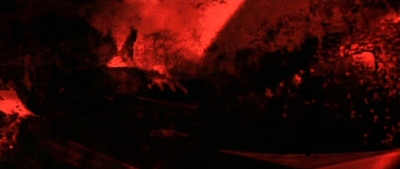
The first three instances of these all-red inserts, especially the two with facial close-ups, reminded me instantly of the fade to blood red inserts of the women characters in Bergman’s Cries and Whispers.
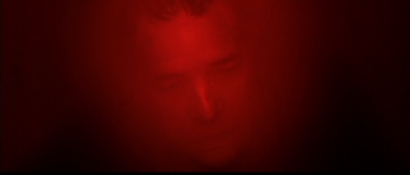
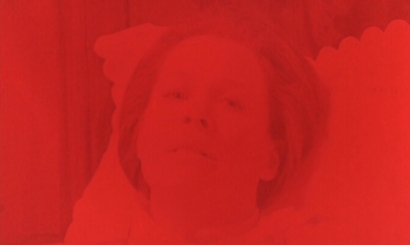
Cries & Whispers (bottom)
But this abstract fifth version suggests something else, something even more disturbing in its tone and, as perseverance would have it, subliminal imagery. Watching it in real time made me feel uneasy, as if I was missing catching a glimpse of something elusive but potentially important. This made me rewatch it several times, backward and forward, at different speeds (not unlike Cain himself with his surveillance footage!), until a shocking revelation: nestled within the rapid-fire abstract imagery are several subliminal edits of a human face, in a state of apparent distress or anguish, an image with strong echoes of the subliminal ‘demon mask’ face in The Exorcist. The face seems more female than male…could it be the mysterious seductress from his past back to haunt him? With this development in mind, the sequence can now be seen as an extension of the previous four, the move toward further abstraction perhaps a signifier for Cain further losing touch with reality, or descending further into complete anguish or madness.
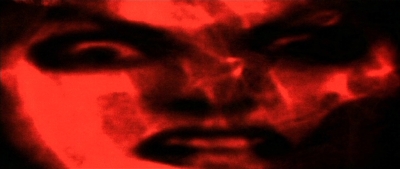
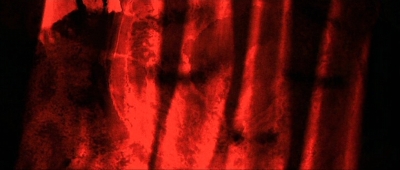
Fear X’s Subliminal Facial Image. Female?
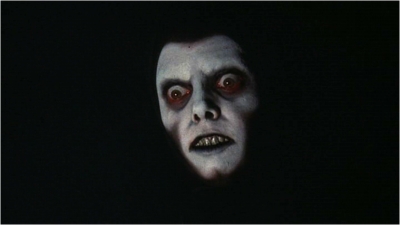
The Exorcist Subliminal Demon Mask Face
Returning back to the hotel, the elevator door shuts, and the dream image of the blood-water soaked hotel room cuts to a mundane hospital scene. We see an overhead three-shot, Cain lying in a hospital bed, and an officer asking “Why did you go after him?” After a long silence, Cain replies, “He murdered my wife.” The stone-faced officers ask him, “Who was he Cain. The man you killed?” (Can this be a reverse persecution complex of Northrup’s murder of the cop?) A third officer, the one from the diner, enters to call the questioning officer out of the room, while we see them through the glass walls silently gesturing and talking, evoking a sense of conspiracy and coercion. The officer returns to tell Cain that after an extensive search there was no evidence of crime or a corpse to be found anywhere at the hotel. “There was no body Mr. Cain. Not even the surveillance tapes show anything” (as if to lay to waste his years of obsessive hunting); if anything, it would be HIS corpse that should be at the hotel, since he was the one shot, but this confusion of identity is yet another indicator of Peter Northrup’s illusory nature. As the camera slowly dollies into Cain, the officer continues to talk off-screen: “We know what happened to you. You can’t change what was. What used to be.” For the first time, Cain shows outward emotion, breaks down and cries. The scene ends with the same high angle three-shot.
The hospital scene gives way to the ultimately disappointing final scene of the film. The diner police officer drives Cain to his car in the middle of a desert highway (he couldn’t have possibly left it there?). Cain exits, the officer gives him his suitcase and car keys and drives off. Cain walks to his car, looks around the empty landscape (camera panning his point of view), and then his final gesture, which is to toss the handful of polaroids pertaining to the Montana events in the air, as if to accept his fate of remaining in the dark as to why his wife died. The gesture seems a tad restraint and too low key coming from a man who has experienced such a painful exodus from a normal life. He gets into his car and drives off. The action of a tortured hero ending up alone on a deserted stretch of highway of course looks ahead to the ending of Drive, and back to the opening/closing of Lynch’s Lost Highway, but the overall dramatic weight somehow misses the mark.
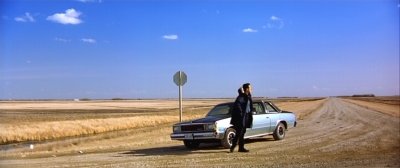
Though this ending disappoints, up until this point, Fear X has been an engrossing exercise in, to quote Pier Paolo Pasolini from his 1965 essay, “The Cinema of Poetry,” Free Indirect Subjectivity or Discourse, where, through a series of interlocked discursive strategies, the author, Refn in this case, gives the viewers the necessary material to imagine the world through Cain’s subjectivity (which is not the same as saying that the viewer experiences the world as if he or she were in Cain’s shoes). To quote Pasolini, “[free indirect discourse] is, simply, the immersion of the filmmaker in the mind of the character and the the adoption on the part of the filmmaker not only of the psychology of his character but also his language” (p. 175).
However, of much more interest than the final scene are the final credits, where we see the frame divided into equal squares (from 1 to 9), alternating between video surveillance images from the mall and the concluding film credits. The act of showing us these random surveillance video images places us in the position of Cain, forcing us to look for a clue that might make sense of Cain’s quest, or indeed, help us find our own meaning.
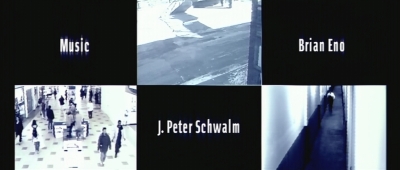
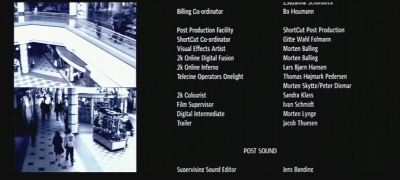
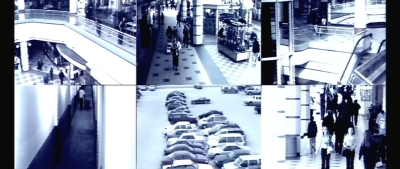
The very last such image is the murder itself, from a high angle, two people enter the frame from opposite ends. The person in dark clothing shoots the other person, who falls dead to the ground and walks around the top pillar, back into and out of the bottom of the frame. The action seems over but Refn tantalises us further with the shadow of a third person moving past the cement pillar on the upper right of the frame. Even though we know there were two murders, we only ever see two people represented in the footage screened by Cain on his television. Hence we, or at least those who notice the subtle shadow, are now left to ponder this third person. Is it Cain? Is it the murdered cop? Is it Peter Northrup? Is it Claire?
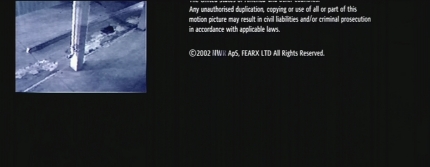
To compound matters, looking closely at the choreography of this murder reveals an even deeper mystery: the choreography appears substantially different in the final credit footage than the footage Cain watches earlier in the movie on his wide-screen television set. The entry point of the victim into the frame is different, as is the positioning of the two figures at the point of gunfire, and where the corpse falls. These differences can perhaps be accounted for if we say that the first time we see the footage it is Victim One that dies, and the second time it is Victim Two. But the Victim is wearing the same white coat in both versions. Something in the killing footage just does not quite add up. In the first instance watched by Cain, noted here as Surveillance Video Cain Version, the killer shoots Victim One at close range and then turns 180 degrees to fire at Victim Two (Claire, we assume) off-screen. See stills below:
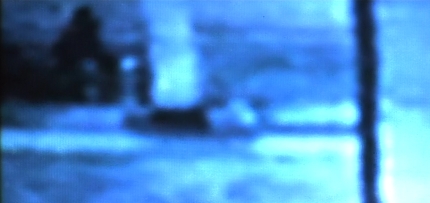
Killer shoots Victim 1
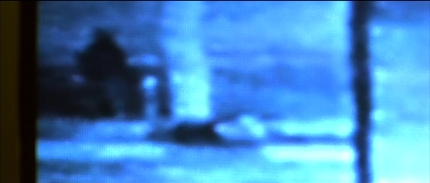
Killer turns to face Victim 2
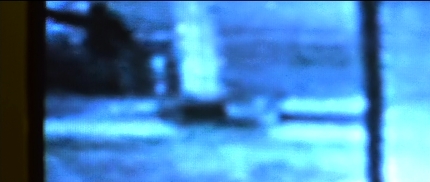
Killer shoots Victim 2, unseen
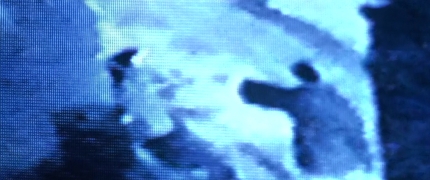
Killer shooting Victim 1 from another angle
In the second version, named Surveillance Video Final Credits Version (the top frame), the killer walks into the frame, shoots the victim (at a farther distance than in Version1) and then turns and walks out of the frame. The killer does not turn to shoot a second time, as in Version 1. Moments later a shadow appears next to the pillar nearest to the corpse. See stills below.
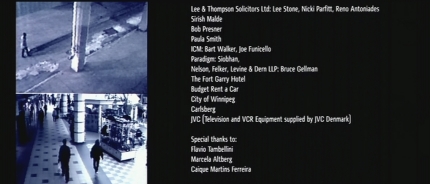
Victim 1 enters frame left
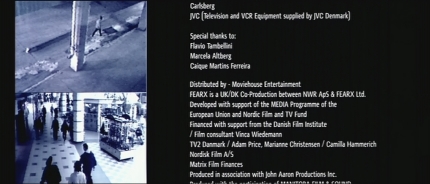
Victim 1 nears far pillar
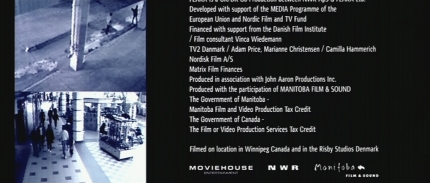
Killer enters from right and shoots Victim 1
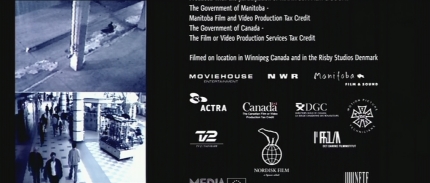
Victim falls to the ground, killer moves behind the pillar
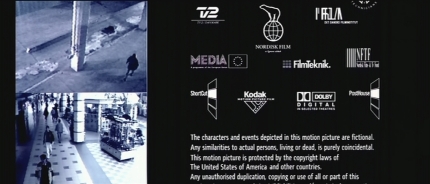
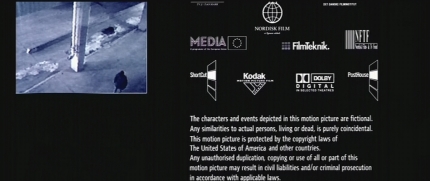
Killer re-enters frame
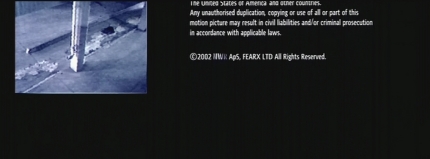
Killer exits frame…shadow appears behind top pillar
Admittedly, almost nobody in their right mind would pick up these differences after one viewing. The differences can be attributed to happenstance or continuity error, but Refn is far too calculating (and far too clever) in every other aspect and moment in the film for me to accept that. It just becomes the mystery but on another metaphysical level.
Fear X is a self-admired title in Refn’s filmography, even if it was mostly self-financied and its box-office failure put Refn about 1 million dollars in the red and caused his production company Jang Go Star to implode (the detailings of the production and economic hell this triggered is the subject of the engrossing 2006 documentary by Phie Ambo, Gambler). It must also be seen as a failure from the standpoint of being his first English-language film and an attempt to break into the mainstream market. But on the other hand, it was his first film to successfully, and arguably most effectively, marry a popular genre (in this case the thriller) with the more esoteric stylings of the art house film, opening the way for Refn’s treatment of this blend in Bronson, Valhalla Rising and (in a more commercially viable form) Drive. On its own, Fear X is a tightly scripted puzzle, with pieces (bits of dialogue, set details, gestures, movements) so intricately woven that only repeated viewings can bring out a full appreciation of its darkly atmospheric, ambiguous, and ultimately impenetrable meanings.
Endnotes
1 Ok, I need to do other things with my life, so need to stop thinking about this film, but it is so formally duplicitious that another thought that comes to mind is that the ‘blurring’ of the killer’s identity in the photo is of Cain’s own subjective design because, for psychological reasons, he does not really want to solve the mystery, to end the quest which gives his life meaning.
Bibliography
Michael Barrett. “While We Were Dreaming Millennial Unreality at the Movies.” Video Watchdog, no. 152, Oct/Nov 2009, 18-33.
Pier Paolo Pasolini. “‘The “Cinema of Poetry.”’ 1965. Heretical Empiricism. Trans. Ben Lawton and Louise K. Barnett. Washington: New Academia, 2005. 167-186. Quoted in David Heinemann, “The Creative Voice: Free Indirect Speech in the Cinema of Rohmer and Bresson.” Online. [Accessed on May 23, 2013]
Bertrand Russell. Problems of Philosophy.



